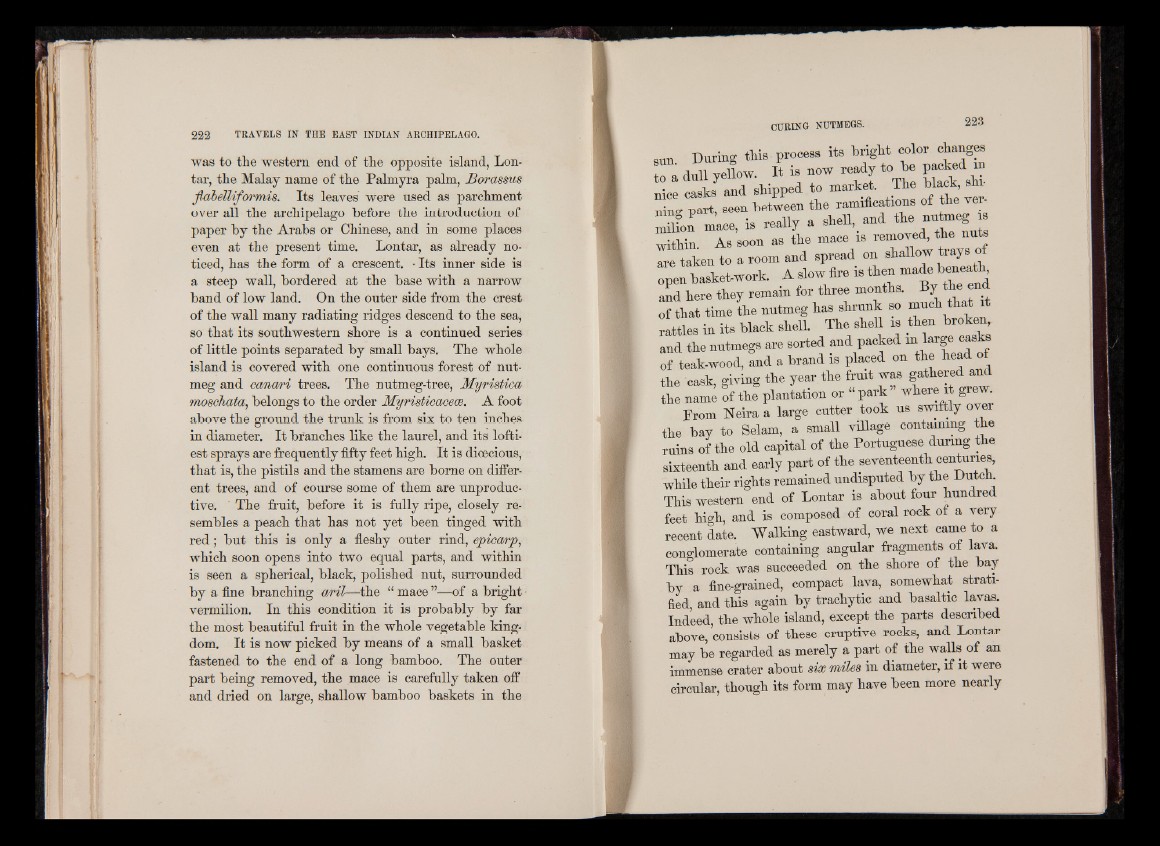
was to the western end of the opposite island, Lon-
tar, the Malay name of the Palmyra palm, Borassus
jlabelliformis. Its leaves were used as parchment
over all the archipelago before the introduction of
paper by the Arabs or Chinese, and in some places
even at the present time. Lontar, as already noticed,
has the form of a crescent. • Its inner side is
a steep wall, bordered at the base with a narrow
band of low land. On the onter side from the crest
of the wall many radiating ridges descend to the sea,
so that its southwestern shore is a continued series
of little points separated by small bays. The whole
island is covered with one continuous forest of nutmeg
and ca/na/ri trees. The nutmeg-tree, Myristica
moschata, belongs to the order Myristicacece. A foot
above the ground the trunk is from six to ten inches
in diameter. It branches like the laurel, and its loftiest
sprays are frequently fifty feet high. It is dioecious,
that is, the pistils and the stamens are borne on different
trees, and of course some of them are unproductive.
The fruit, before it is fully ripe, closely resembles
a peach that has not yet been tinged with
re d ; but this is only a fleshy outer rind, epicarp,
which soon opens into two equal parts, and within
is seen a spherical, black, polished nut, surrounded
by a fine branching aril—the “ mace ”—of a bright
vermilion. In this condition it is probably by far
the most beautiful fruit in the whole vegetable kingdom.
It is now picked by means of a small basket
fastened to the end of a long bamboo. The outer
part being removed, the mace is carefully taken off
and dried on large, shallow bamboo baskets in the
m . During this process its bright color changes
a .1 1 yellow. I t is now ready to he packed in
“ 1 part, seen between the ramifications of the vermilion
mace, is really a shell, and
within As soon as the mace is removed, the nuts
I taken to a room and spread on shallow trays of
open basket-work. A slow tire is then
and here they remain for three months. By the end
of that time the nutmeg has shrunk so m u c h that it
rattles in its black shell. The shell is then broken
and the nutmegs are sorted and packed ml large cas
of teak-wood, and a brand is placed on the head of
the cask giving the year the fruit was gathered and
M M l i the plantation or I park where it grew.
From ISTeira a large cutter took us swiftly over
the bay to Selam, a small village containing the
ruins of the old capital of the Portuguese dunng the
sixteenth and early part of the seventeenth centunes,
while their rights remained undisputed by the Dutch
This western end of Lontar is about four hundred
feet high, and is composed of coral rock of a very
recent date. Walking eastward, we next came to a
conglomerate containing angular fragments of lava.
This rock was succeeded on the shore of the bay
by a fine-grained, compact lava, somewhat stratified,
and this again by trachytic and basaltic lavas.
Indeed, the whole island, except the parts described
above, consists of these eruptive rocks, and Lontar
may be regarded as merely a part of the walls of an
• ___ j „ 4- Ava/jl/jo i n f l i a m p . + .A r i f i t . W fV P fi